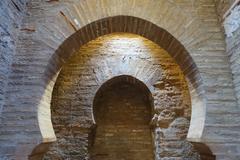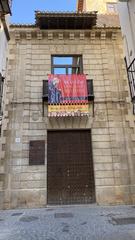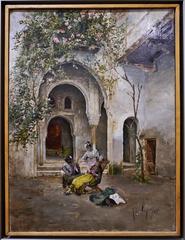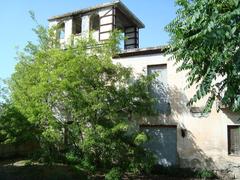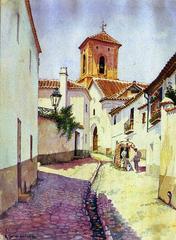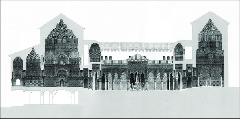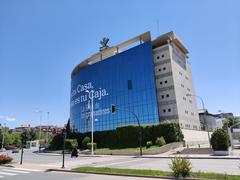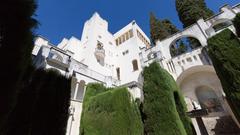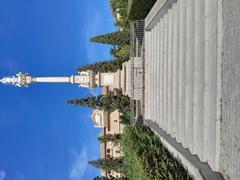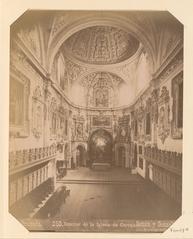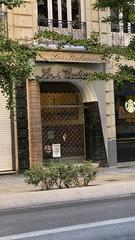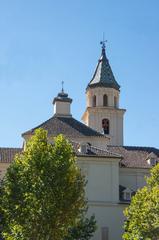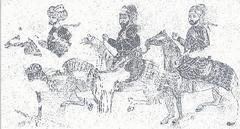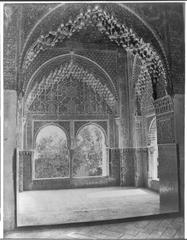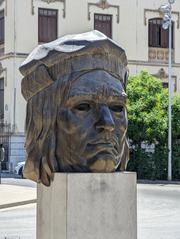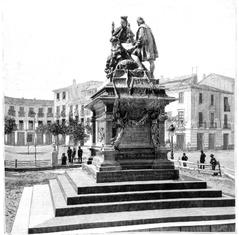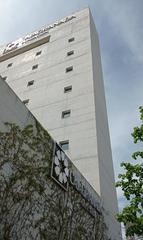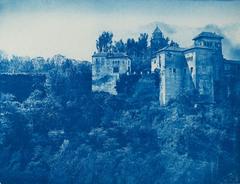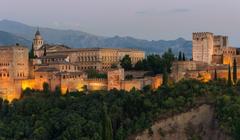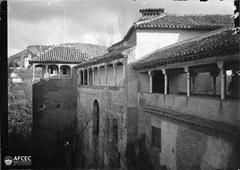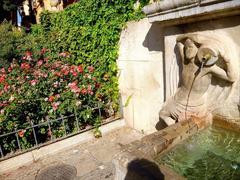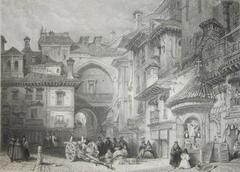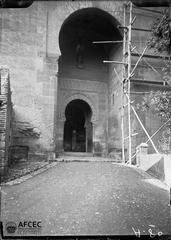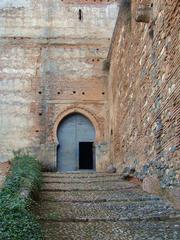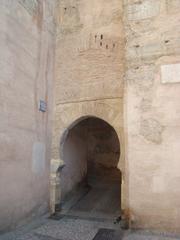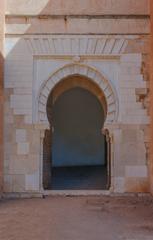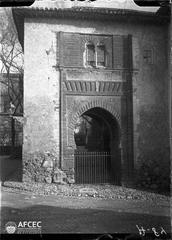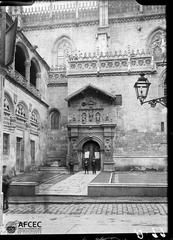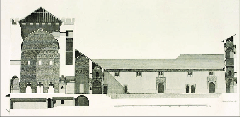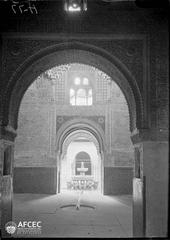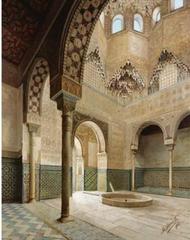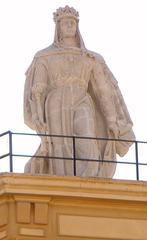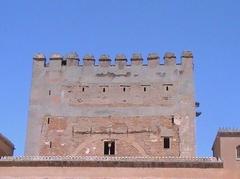Casa de los Mascarones, Granada, Spain: Visiting Hours, Tickets, and Historical Sites Guide
Date: 14/06/2025
Introduction
Located in Granada’s UNESCO-listed Albaicín district, the Casa de los Mascarones is a distinctive architectural and cultural landmark. Famous for its striking mascarones—stone-carved faces intended to ward off evil—this house encapsulates centuries of artistic evolution, blending Hispano-Muslim, Renaissance, Mudéjar, and Baroque influences. Once the home of the poet Pedro Soto de Rojas and later the sculptor José de Mora, the Casa’s façade remains a highlight for visitors and historians, even as its interior is closed to the public for conservation (albaicin-granada.com; granadahoy.com; rinconesdegranada.com). This guide provides essential information about the Casa’s history, architecture, cultural relevance, practical visitor tips, and nearby attractions.
Table of Contents
- Introduction
- Historical Background and Architectural Evolution
- Cultural and Artistic Significance
- Visitor Information
- Architectural Features
- Symbolism and Cultural Significance
- Visiting Hours, Tickets, and Accessibility
- Nearby Attractions and Travel Tips
- Casa De Los Mascarones Tapas Bar Experience
- Frequently Asked Questions (FAQs)
- References
Historical Background and Architectural Evolution
Origins and Historical Context:
The Casa de los Mascarones originated from several Morisco homes dating to the late 15th century, accessed via a private adarve, or alleyway—a hallmark of Hispano-Muslim urbanism. In the early 17th century, poet Pedro Soto de Rojas unified these properties, creating a residence that became a center for Granada’s artistic and literary life. The Baroque sculptor José de Mora later resided here, further enhancing its cultural legacy (albaicin-granada.com; rinconesdegranada.com; granadahoy.com).
Architectural Evolution:
- Hispano-Muslim Foundations: The Casa retains features like the adarve, a subterranean water gallery linked to local cisterns, and elements such as overhanging eaves and twin windows (ajimez) that showcase a blend of Islamic and Christian influences (pacopelegrina.com).
- Renaissance and Mudéjar Transformations: 17th-century renovations introduced decorative “mascarones,” geometric cornices, and commemorative plaques. The roofline merges Gothic and Renaissance motifs (albaicin-granada.com).
- Gardens and Layout: Historically, the house featured a “carmen albaicinero”—a walled garden with terraced levels and a pond—which reflected the private, sensory-rich environments admired in both Islamic and Renaissance traditions.
Cultural and Artistic Significance
The Casa de los Mascarones is emblematic of Granada’s multicultural heritage. Its ties to Pedro Soto de Rojas and José de Mora cement its place in the Spanish Golden Age of art and literature. The restrained façade belies the artistic richness of its historic gardens and interiors, embodying the nuanced blend of modesty and grandeur for which Granada is known (granadahoy.com).
Visitor Information
- Location: Calle Pagés 20, at the end of Calle del Agua, Albaicín, Granada.
- Visiting Hours & Access: The house is private and not open for interior visits. The façade can be admired from the street. Occasionally, guided exterior tours are offered as part of cultural events (rinconesdegranada.com).
- Tickets: No tickets are required as the site is not open to the public.
- Accessibility: The Albaicín’s narrow, steep streets may pose challenges for those with limited mobility; comfortable footwear is recommended.
- Nearby Attractions: Alhambra, Mirador de San Nicolás, and Granada Cathedral are within walking distance or a short taxi ride.
Architectural Features
- Exterior Façade: Notable for its mascarones—unique stone faces above doors and windows—that are both decorative and symbolic, reflecting Baroque and Renaissance influences (Wanderlog).
- Courtyard and Patio: The traditional Andalusian layout centers on a patio with patterned tiles and a central fountain, surrounded by arcaded galleries.
- Decorative Elements: Features Mudéjar, Renaissance, and Baroque details such as glazed azulejos, intricate plasterwork, and wooden artesonado ceilings.
- Structural Techniques: Traditional Andalusian construction includes thick masonry walls, wooden beams, and water features for climate control.
Symbolism and Cultural Significance
The mascarones serve as protective symbols and status markers, while heraldic motifs assert the noble lineage of the house’s historical owners. The architectural fusion found here mirrors Granada’s layered cultural history—a testament to centuries of Christian, Muslim, and Jewish coexistence.
Visiting Hours, Tickets, and Accessibility
- Current Status: Casa de los Mascarones remains closed to the public due to conservation needs (Granada Hoy).
- Tickets: Not available until the site is restored and opened for tours.
- Future Accessibility: Restoration plans include improved accessibility, but the historic structure may limit full access in some areas.
- Getting There: Accessible by foot from Plaza Nueva or by local bus; the area is pedestrian-friendly but features steep, cobblestone streets.
Nearby Attractions and Travel Tips
- Must-see Sites: Alhambra Palace, Mirador de San Nicolás, Carrera del Darro, and the Royal Chapel.
- Tips: Visit early in the day to avoid crowds, wear comfortable shoes, and use public transport due to limited parking in the Albaicín.
- Safety: The area is generally safe, but standard precautions against pickpocketing are advised.
Casa De Los Mascarones Tapas Bar Experience
Adjacent to the historical site, the Casa De Los Mascarones tapas bar offers an authentic Andalusian dining experience in the heart of Albaicín.
- Ambiance: Traditional décor and a lively, welcoming atmosphere attract both locals and tourists (Culture Themes; Granada Map).
- Cuisine: Enjoy complimentary tapas with each drink—specialties include migas con sardinas and habas con jamón (Restaurant Guru).
- Hours: Typically opens around 5:00 pm and stays open until midnight or later; peak hours are 7:00–10:00 pm (GastroRanking).
- Reservations: Not required; walk-in only.
- Payment: Cash and major credit cards accepted.
- Nearby: Close to Puerta de las Pesas and the Mirador de San Nicolás.
Frequently Asked Questions (FAQs)
Can I visit the interior of Casa de los Mascarones?
No, the building is currently private and closed for conservation.
What is the significance of the mascarones?
They are decorative stone faces believed to offer protection and reflect the status of the house.
Where is Casa de los Mascarones located?
Calle Pagés 20, Albaicín, Granada.
Are guided tours available?
Some cultural walking tours of Albaicín include exterior visits and historical commentary.
Is the tapas bar part of the historical house?
No, but it is nearby and named in reference to the historic mascarones.
References
- Casa de los Mascarones in Granada: History, Architecture, and Visitor Guide, 2024 (albaicin-granada.com)
- Granada Hoy, 2024, Cultural Heritage and Artistic Legacy of Casa de los Mascarones (granadahoy.com)
- Rincones de Granada, 2024, Casa de los Mascarones Overview and Architectural Details (rinconesdegranada.com)
- Wanderlog, 2024, Casa de los Mascarones Architectural Features (wanderlog.com)
- Culture Themes, 2024, Exploring Granada’s Albaicín (culturethemes.com)
- Restaurant Guru, 2024, Casa De Los Mascarones Bar Reviews and Visitor Information (restaurantguru.com)
- Granada Hoy, 2024, Heritage Preservation Challenges and Advocacy (granadahoy.com)
Summary
The Casa de los Mascarones is a vivid symbol of Granada’s layered history, representing the convergence of Islamic, Christian, and Renaissance traditions. Though closed to public interior visits, its façade and storied past offer a fascinating glimpse into Andalusian heritage. Visitors can enjoy the surrounding Albaicín district, sample local tapas, and look forward to future restoration efforts that may open this architectural treasure to the world. For the latest updates, guided tours, and cultural highlights, download the Audiala app and explore additional resources on Granada’s historical sites.

